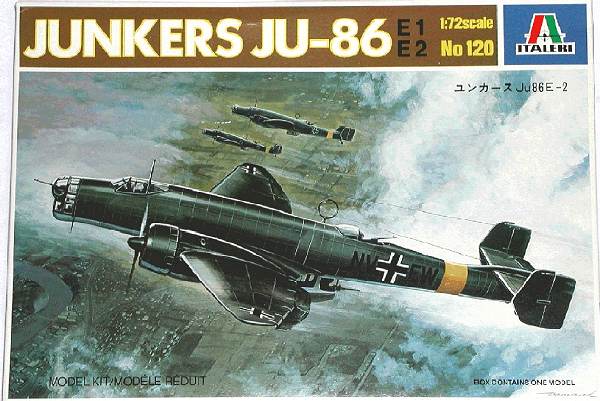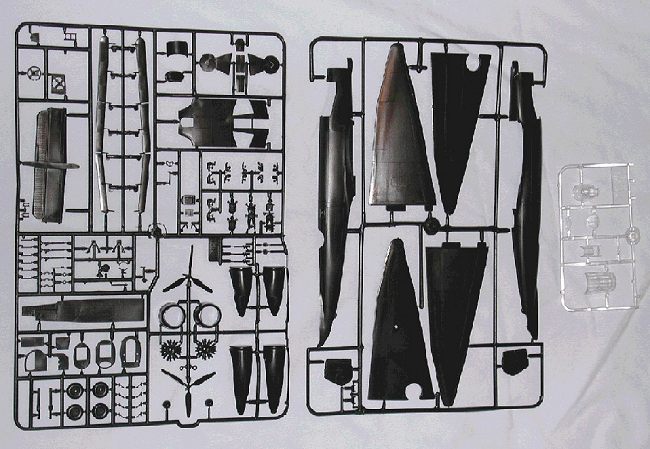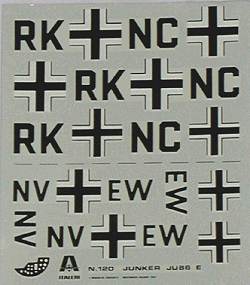
|
KIT: |
Italeri 1/72 Ju-86 E-1/2 |
|
KIT # |
120 |
|
PRICE: |
$20.00 |
|
DECALS: |
Two aircraft |
|
REVIEWER: |
|
|
NOTES: |
Older injection molded kit |

|
HISTORY |
History: Somewhere in the large shadow cast by the He 111 lies the lesser known
Junkers 86. Conceived at the same time as the He 111, the Ju 86 suffered from
undesirable handling characteristics and temperamental engines. These
drawbacks were never entirely overcome and relegated the bomber to a secondary
role in light of the success of the He 111.
The Ju 86 was designed at a time when foreign eyes were carefully watching
aircraft development in Germany. Despite being limited to the construction of
civil types, the Ju 86 was developed with both civil and military roles in mind
(as
was the He 111). The aircraft was equipped with water-cooled, inline diesel
engines in an attempt to create a fuel-efficient aircraft. Unfortunately, while
the Jumo 205s were great for the constant power settings of civilian aircraft,
they did
not perform well under normal military conditions.
Work on the “E” model was started relatively late in the game to overcome the
deficiencies of the original Jumo engines. Development started as an offshoot
of the “K” models built for export. Equipped with Pratt & Whitney Hornets and
Bristol Pegasus radials, the “K” variants performed much more reliably than the
Luftwaffe’s Jumo-powered examples. This led to a Luftwaffe order for a Ju 86
equipped with the BMW 132 series of radial engines, a license-built version of
the Hornet. The BMW engine was much easier to maintain and far more reliable
than the water-cooled Diesels with all of their inherent vices. By that time,
however, the Ju 86 was being phased out of production and only around 50 “E”
models were completed. Only one Ju 86 survives today, a K-4 model at the
Flygvapenmuseum Malmen in Sweden.
|
THE KIT |

I’m not really a Luftwaffe type, but I’ve always liked the Ju
86 and jumped at the chance to get this “E” model for half price on eBay. What
you find upon opening the undated box are two large sprues of dark green plastic
and one sprue of clear bits. The plastic features raised panel lines (not quite
delicate, but not too bad either) and my example had minimal traces of flash.
You’ll have a few injector pin marks to deal with on the landing gear doors and
bomb bay, but they’re relatively minor. All of the parts appear to be
well-formed with no sink marks. For those who like to add life to their
aircraft,
 there are four crewman you can add. (These four figures make up 17 of the 115
parts!) None of the plastic was bagged so the clear bits were a little
scratched. They’re thin, but a little milky. I’m hoping a dip in Future will
clear them up (no pun intended). Given their similarities, you could convert the
kit to “K” standards fairly easily.
there are four crewman you can add. (These four figures make up 17 of the 115
parts!) None of the plastic was bagged so the clear bits were a little
scratched. They’re thin, but a little milky. I’m hoping a dip in Future will
clear them up (no pun intended). Given their similarities, you could convert the
kit to “K” standards fairly easily.
The kit instructions show you four steps to complete this model. They will
leave you guessing in a couple of places and careful study is required to make
sure everything ends up where it is supposed to. The instructions note that the
Lewis
gun (part 30A) should not be used with the Luftwaffe version and since both
aircraft are Luftwaffe versions, go ahead and put them in your parts bin.
Your only options would be to build the aircraft gear up and close the bomb bay
doors. (I guess if you suspend the aircraft from your ceiling you also
have the option of lowering the dust-bin gunner’s position.)
The decals are look to be o.k., though very matte. Your options are for a
Stalingrad bird from 1942 and a Neubranchenburg aircraft from 1940. The decals
simply comprise your basic aircraft codes and crosses. The Stalingrad bird is
the most “colorful” and that’s the one I’ll probably build. As is typical
Italeri, there are no swastikas.
|
CONCLUSIONS |
If you want a 1/72 Ju 86, this is it. While the kit has some drawbacks (lack of interior detail and raised panel lines), it is still pretty nice. The exterior detail is pretty good and, as one who spends very little to no time on a model’s interior, I’m happy. Comparing the plastic with line drawings in William Green’s The Warplanes of the Third Reich, I’d say Italeri has done a good job of capturing the look of the Ju 86, right down to the cranked wing. Recommended to intermediate modellers and above due to the semi-helpful instructions and fiddly bits.
If you would like your product reviewed fairly and quickly where it will be seen by well over 150,000 visitors a month, please contact me or see other details in the Note to Contributors.